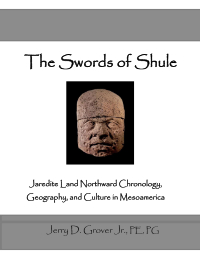Introduction
This book is an effort to situate the history of the Jaredites as narrated in the Book of Ether in the chronological, geographical, and cultural context of ancient Mesoamerica.
This work has grown out of earlier works by the same author.
In doing geologic analysis of the destructions in 3 Nephi for my 2015 Geology of the Book of Mormon, using distances of earthquake attenuation from the Veracruz fault system I was able to identify the probable geographic area where the city of Gilgal was located before it was destroyed. Because this same locale, the valley of Gilgal, is also mentioned in the Book of Ether, it was clear that this location might be utilized to better understand Jaredite geography.
In completing a translation of the Caractors Document (Translation of the "Caractors" Document [2015]), it became apparent to me that some of the place names contained in the Book of Mormon are actually descriptors of the places themselves. This is not an unusual phenomenon, as it occurs anciently in the Bible, in other ancient cultures, and all over the world today in many cultures, including the United States (i.e. Niagara Falls, Salt Lake City, etc.). Nor is it an entirely new way to view Book of Mormon names, since the Book of Mormon openly indicates that approach to some geographic names:
Ether 15:8
And it came to pass that he came to the waters of Ripliancum, which, by interpretation, is large, or to exceed all;
It seemed prudent to attempt to determine any potential etymologies of Jaredite place names that might give some insight in helping reconstruct some more specific plausible locations for Jaredite places. This led to the publication of my most recent book Sumerian Roots of Jaredite-Derived Names in the Book of Mormon (2017).
As is the case with most of my inquiries, here I chase interesting spin-offs or unsolved questions related to the initial thrust of my research. As a result, this book contains other wide ranging relevant issues and topics related to the Jaredites, with all them looking at some new data, new approach, or new insights for the reader to consider.
This work's primary purpose is to provide new and hopefully interesting insights about the Jaredites and the land northward. This work is designed to augment the recent works by Brant A. Gardner (Traditions of the Fathers; The Book of Mormon as History, 2015) and John L. Sorenson (Mormon's Codex, 2013). Reading those books prior to the present book would provide a helpful background for understanding this one.
It is hoped that this effort will provide a better working geography of the Jaredite civilization, and provide some additional insights into Jaredite calendrical information for other researchers of the Book of Mormon. It should be noted at the outset, that Don Bradley's input has significantly contributed to this book in the form of drafting introductions and segues, and I have had ongoing discussions with Don about various topics and elements in the book. Specifically, Don should be considered as the originator of the idea of the relationship between the Biblical Og and Gath in regards to the place name Ogath having a common theme of giants, although I took that idea and incorporated it into its Mesoamerican setting. Don's input and original ideas are also intertwined into the discussion and application of the Fayette Lapham information, as it is also a source for Don's current research and upcoming book, The Lost 116 Pages: Rediscovering the Book of Lehi, forthcoming from Greg Kofford Books, 2019.
The present book divides naturally into three sections, covering, respectively, Jaredite chronology, geography, and culture.
Section I, Chronology, sketches the Jaredite calendar system and uses textual analysis of the Book of Mormon and the archaeology and natural history of Mesoamerica to establish a chronology of Jaredite history, including a chronology of the formative event behind Jaredite society—the "confounding" of language at the "great tower."
Section II of this book, Geography, describes Jaredite geography from the "great tower" at the beginning of the Jaredite narrative through the stages of Jaredite national history and then into the post-Jaredite period when Jaredite lands became Nephite and Mulekite lands. This section builds heavily on earlier work in Book of Mormon geography but seeks to considerably extend that work. In addition to using such traditional methods as mapping the action in the text and comparing this to topographical and archaeological features of the land, this section will pioneer linguistic methods of reconstructing Book of Mormon geography.
Our final section, Section III, will explore a potpourri of aspects of Jaredite culture, including material culture, linguistic culture, numeric systems, metallurgy, and the most important relic surviving Jaredite society—the twentyfour plates. Among other questions, this section will examine the origin of the Nephite glyph representing the name Jared, the relationship of the colossal Olmec stone heads to the Jaredite kings, whether the Sumerian numeric system brought by the Jaredites influenced Mesoamerican numeric systems, the significance of Ether dwelling "in the cavity of a rock," the cultural significance of the steel swords of Shule, the Book of Mormon relevance of the Olmec practice of buying weapons, and contents and character of the twenty-four Jaredite plates.

